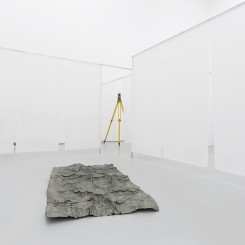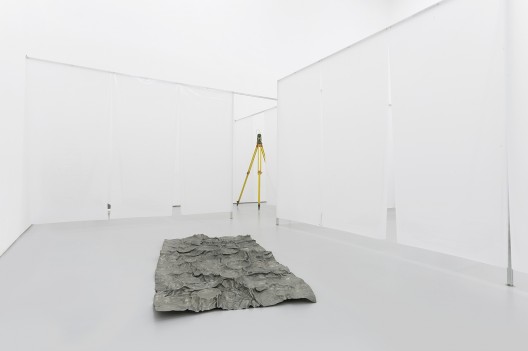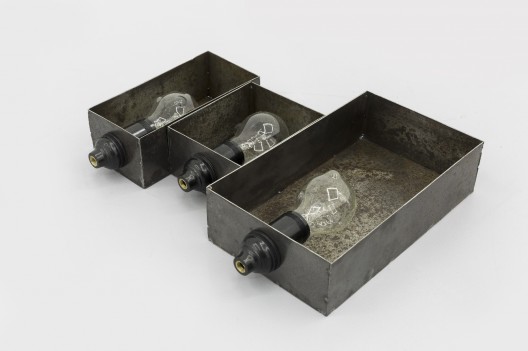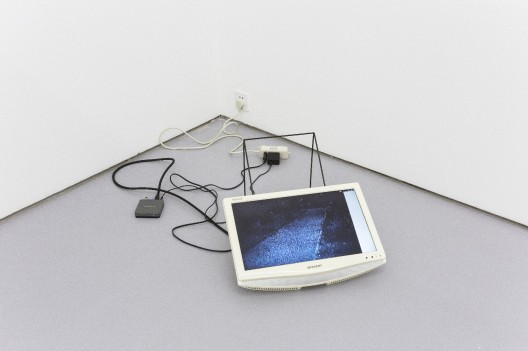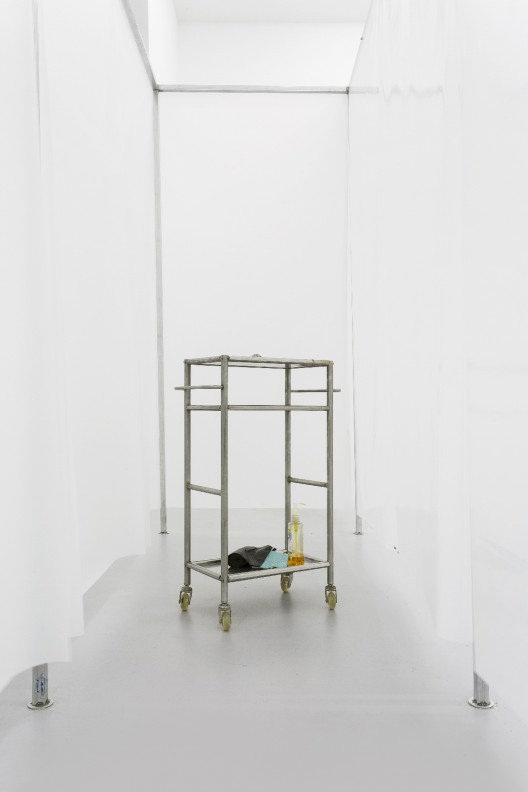Yang Jian: “The Beginning of Infinity”
White Space (No.255, Caochangdi Airport Service Road Chaoyang District Beijing 100015), Apr 23 – May 29, 2016
The poet and conceptual artist Vito Acconci, a seminal figure of New York’s experimental art scene in the 1970s, tried to make “architecture” using words and language. He created poems in which the sound of the voice and its pitch, the words and images would evoke the perception of spatial relationships, plans, volumes and other structural elements, establishing a simultaneous space in which architecture and language would exist together and mirror each other. Since becoming a full time architect, Acconci has tried to recreate this correspondence with his designs.
Yang Jian’s exhibition “The beginning of infinity” engages with a different, but parallel experiment. According to the exhibition’s introduction: “This exhibit showcases a novel written by Yang Jian about time, routes and ‘the final destination’ through the form of a labyrinth built by an anonymous architect who happens to have left some notes behind.” Our journey into this maze (built using metal stands and long, translucent white plastic sheets) starts as if we were entering a mysterious scientific institution, the whereabouts and purposes of which are not given.
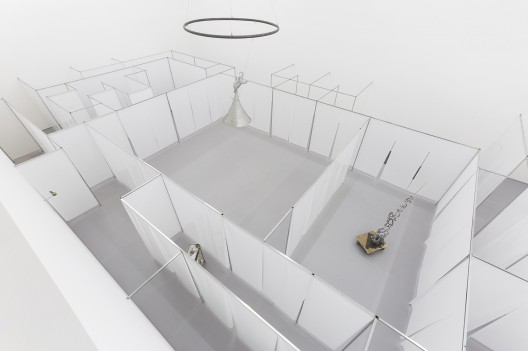
Yang Jian, “Labyrinth”, galvanized iron pipe, frosted glass tint, silk-screen printing, magnet, masking tape, dimensions variable, 2016
In the corners, at every new turn, one can read on the sheets sentences and notes which provide some insight into the architect’s building process and fragments of life that embody or run parallel to their train of thought. The labyrinth’s width is limited: large enough for just one person. The metal stands and the plastic sheets are cold and mute. Their pristine logic of repetition forces the visitor through a specific path which, potentially, could be subverted and challenged (the sheets-walls are soft and movable) but that, in reality, has an intense psychological power; one’s perception is quickly attuned to a feeling of imprisonment amid the otherness of this artificial environment.
Along the journey we meet various objects and things: some are informal, like a strange hybrid sculpture including a plant with a lead ribbon; some are recognizable, such as an off-white cloth and lead version of Alice’s White Rabbit; some are drawn from daily life, like a metal medical cabinet on wheels, or a surveying instrument mounted on a tripod, or three electric bulbs in iron boxes; among the sculptural forms is a large leaf of lead with an iPad inserted in the middle of it as if occupying the space of a wound. There is a rubber foam piece and monitors with data and a device that is counting the time the artist thinks he has left to live. Apart from the anonymous architect’s words, we have no clue or logic to follow save for the labyrinth itself.
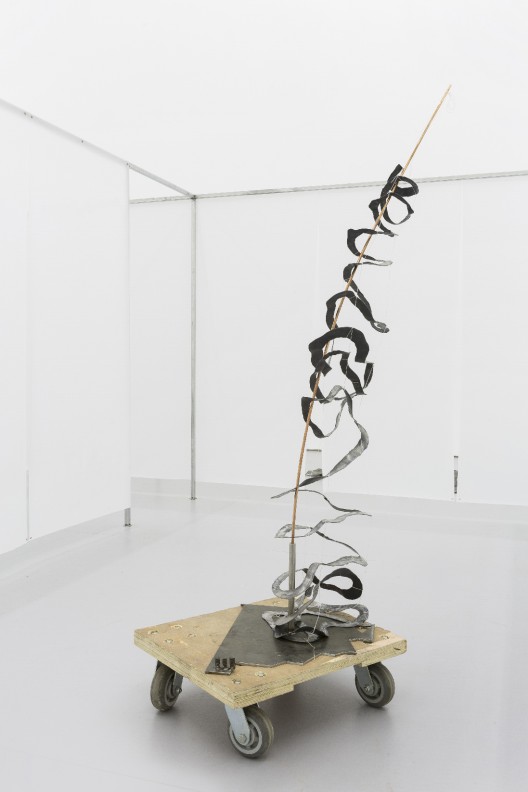
Yang Jian, “Segmentation of Human in Aerial View”, lead sheath, copper, cotton thread, iron board, wood board, wheel, dimensions variable, 2016
All the materials employed are cold: industrial relics, maybe transformed by the hand of a “creator”, or perhaps just abandoned there, assembled by chance, or by an occasional passerby. On a purely artistic level, the exhibition is elegant and sophisticated. As a “plastician”, Yang Jian carefully orchestrates subtle contrasts of surface, texture, color and volume, almost without leaving the spectrum of grey, black and white, with just a few touches of primary and pastel color (pieces of cloth, greenish screens and red digital numbers on LED elements). The way the light travels through the space and is reflected by these various surfaces is also interesting and subtle, alternating its quality from a diffuse space-ship-like milky white to the all absorbing black of rubber, or warm, rusty iron surfaces versus the rich, dense grey-blue of lead.
On a conceptual level, Yang Jian renders tangible a complex physical and mental interpretation of space in which language manifests itself in the form of the labyrinth. This succeeds in being precise and constrictive, but also undetermined, suspended in a silent dimension between straightforward materiality and an unconscious or oneiric archetypal projection.
We might think of being in some of the worlds Borges created, or in one of Calvino’s Imaginary Cities, or equally in a Philip K. Dick short story or Stanley Kubrick’s sequence plan. The infinity proposed by Yang Jian is engaging and disturbing: the world has become language and this language is ultimately selecting and designing our space and restricting our chances to break out in any direction. The labyrinth is almost intangible, light and translucent, and its structural elements can be easily moved or trespassed, endlessly changing configuration; this seems harmless, but slowly all the empty space is being filled, leaving no void and proposing no meaning. Through the conceptual production and distribution of language, we are becoming prisoners in a matrix that endlessly reflects and reproduces her structural complexity without any purpose beside proliferation. The seductive and sophisticated presence conjured here always suggests a “beyond” which, like the sirens’ chants, drive us towards ultimate wreckage that is not an event and does not take place, but nonetheless constantly erodes and erases all traces of and references to our previous existence. The modern and postmodern industrial objects we encounter are, paradoxically, the only elements with an organic quality that resides in their nature as relics of a collective unconscious.
Gaston Bachelard wrote in The Poetics of Space: “Sometimes the house of the future is better built, lighter and larger than all the houses of the past, so that the image of the dream house is opposed to that of the childhood home.” Yang Jian leads us through this labyrinthine house of the future, dropping clues around it that might remind one of a childhood home. We realize, however, that some manmade objects, with their patina of rust and oxidation, their weight, familiar shapes and use and evocative power, are still closer and easier to relate to than the inherent logic of dominance hidden behind the lifeless structural elements composing the house itself.
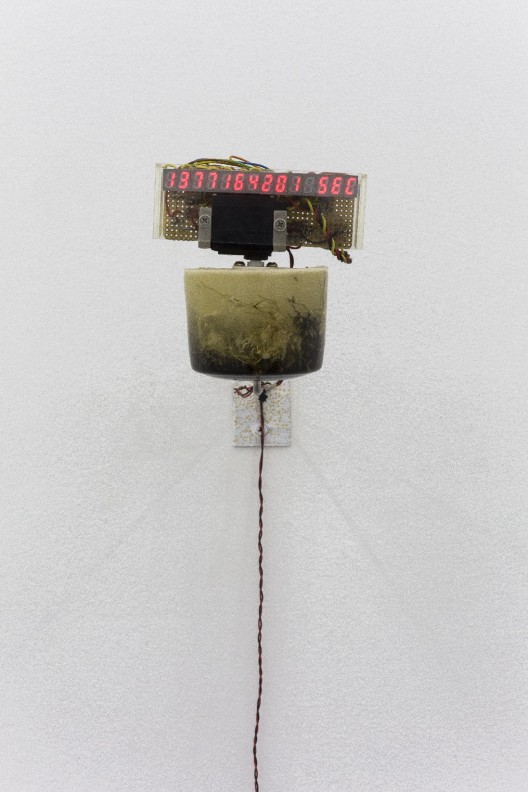
Yang Jian, “Countdown Timer of My Life”, led chip, transparent resin, soil, ruderal, acrylic, 11 × 5 × 12 cm, 2007-2010
Who is the anonymous visionary architect? Are they the artist’s super-ego, or merely a projection of our innate self-deceiving intellectual and emancipatory delusions about art and architecture themselves? Perhaps the answer is hidden somewhere in the folds of this anti-gesamtkunstwerk. “You can check out anytime you like, but you can never leave”.
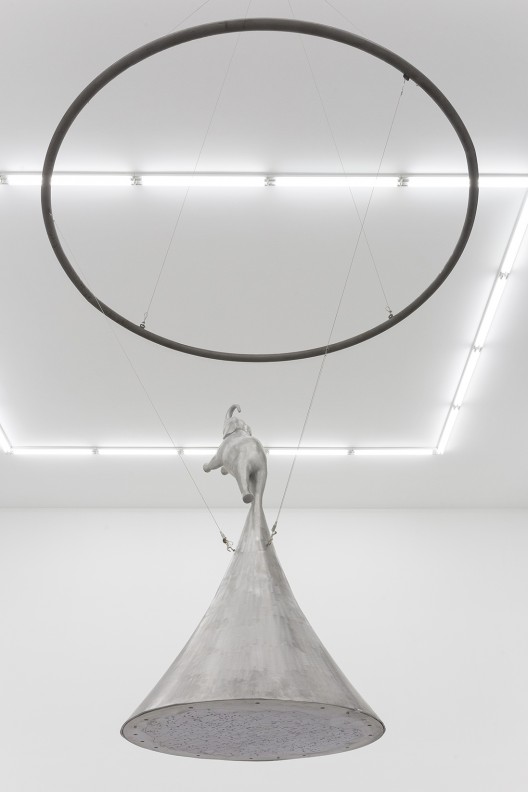
Yang Jian, “SDSS-3939″, aluminum, iron, sdss spectroscopy plate, led light, overall dimensions variable, 2015-16
